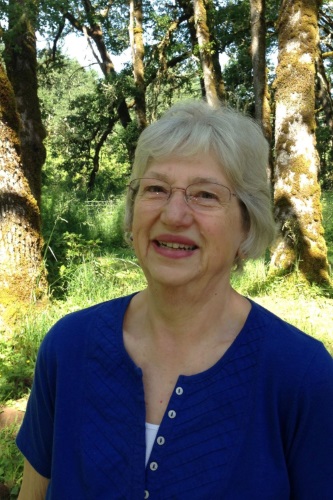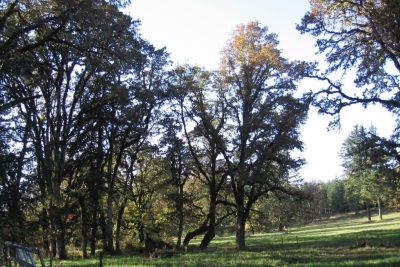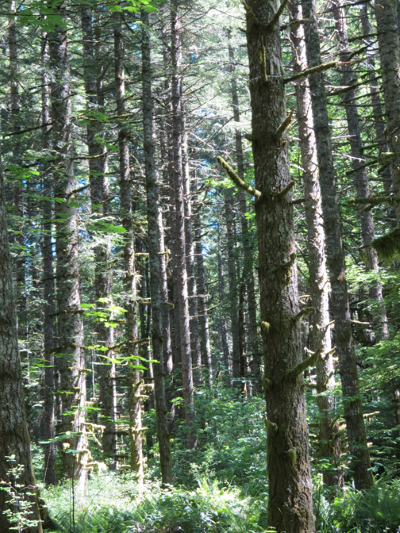Linda Butts of Oregon
What makes them outstanding?
 The Butts family has a long
tradition of being responsible landowners striving to manage their forest in
the best way possible. They became American Tree Farm System certified in 1978
just a few short years after they purchased the property. The family is active
in family forest issues and is recognized by their peers for their leadership.
The Butts family has a long
tradition of being responsible landowners striving to manage their forest in
the best way possible. They became American Tree Farm System certified in 1978
just a few short years after they purchased the property. The family is active
in family forest issues and is recognized by their peers for their leadership.
They lead by example and are always willing to share ideas with neighbors and be part of their local community. The Butts family is commonly known as the family that does things right.Their style of forest management that includes pruning trees to generate the desired forest conditions and improve wood quality is recognized and appreciated by those who know them. They donate their time to help other landowners improve their forest lands and are active members of the family forest landowner community in their native Linn County and throughout the state. They annually assist Oregon State University (OSU) Forestry Extension with its sponsorship of the Clackamas Tree School, one of the premier events in Oregon each year for family forest owners. They also use a non-traditional silvicultural practice of pruning young stands and thinning older stands of Douglas-fir which has generated a lot of interest in evaluating the economic returns of such practices. OSU researcher Tammy Cushing will be evaluating the economic returns of such forestry investments. Their tree farm is routinely used by Extension for tours to demonstrate silvicultural treatments and to demonstrate what afforestation of pastureland can look like after 30-40 years.
Tree Farmer Story
 The property has been
actively managed by the Butts family with a mix of related goals and objectives
for over 40 years. Purchased in 1974 by
Lynn and Linda Butts to raise cattle, it didn’t take long for them to see that
forestry was a better use for the land. By 1988 they planted 50 acres of
pasture to Douglas-fir forests. This property has been managed for
sustainability with tender loving care planting a variety of trees species,
establishing a road system for forest management and fire protection. They raised their family as caring family forest
owners. Lynn and Linda have spent countless hours keeping their forest healthy
and productive. Sons Gary and Thom have been actively involved in the
management of their property and have earned the respect of neighboring family
forest owners. The grandchildren were introduced to the tree farm as a place to
camp and picnic, and have joined in with the forest management activities as
they have grown.
The property has been
actively managed by the Butts family with a mix of related goals and objectives
for over 40 years. Purchased in 1974 by
Lynn and Linda Butts to raise cattle, it didn’t take long for them to see that
forestry was a better use for the land. By 1988 they planted 50 acres of
pasture to Douglas-fir forests. This property has been managed for
sustainability with tender loving care planting a variety of trees species,
establishing a road system for forest management and fire protection. They raised their family as caring family forest
owners. Lynn and Linda have spent countless hours keeping their forest healthy
and productive. Sons Gary and Thom have been actively involved in the
management of their property and have earned the respect of neighboring family
forest owners. The grandchildren were introduced to the tree farm as a place to
camp and picnic, and have joined in with the forest management activities as
they have grown.
With Lynn’s passing in 2006, sons Gary and Thom have taken a more active role in managing the tree farm. Grandchildren Nikii, Chris, and Keith are interested in this same tradition. Family work parties are a common activity. Linda continues the philosophy she and Lynn shared that it is important to give the family a connection to the land through work, such as planting trees, but also through recreation, such as their family campouts. She wants the family to see the tree farm as more than a source of income, but also as a total interconnected ecosystem where plants, animals, and humans can benefit each other.
Tree Farming at its best. For more than 30 years they have been
excellent managers of their own property and mentors to dozens of
other woodland owners in Oregon, taking a "stump farm" and making
it into a showplace forest with both high productivity stands and
protected natural features.”
- Rick Fletcher, Professor Emeritus, Oregon State University
Over the years the proper
management of this property has been a high family priority and they are
willing to share with others. They have
been hosts for woods tours, have demonstrated a variety of management
activities, and been a great example of how to do things right. With their collective knowledge on what makes
a healthy sustainable forest, they have modified their management plans
overtime to reflect that knowledge. A good example is the conservation of an
ecologically unique area of oak woodlands/savanna on their property. Oak woodlands
have been identified in Oregon’s Conservation Strategy as a forest type that
needs to be conserved. Conservation of oak on their property is consistent with the state’s overall oak woodlands conservation strategy.
the state’s overall oak woodlands conservation strategy.
In addition to working to make the property a healthy, sustainable tree farm, they have consistently worked to incorporate this land ethic in their children and grandchildren though work and play projects. These projects not only make the forest sustainable they also make the Butts family ownership of this property sustainable as well. A walk through the property and hearing how the grandchildren value the property gives evidence that both goals are being accomplished. Family work parties are a common thing on the tree farm. This property is truly a family managed property. Linda along with sons Thom and Gary and their families all take pride in this forest and enjoy the role they play in its stewardship, always willing to host landowners wanting to learn how to improve their forests.
Linda and her son Thom have become Master Woodlands Managers, an OSU program where landowners take forest management classes and in return volunteer their time to assist other landowners improve their forest lands. Their outreach to neighbors has been recognized by those neighbors who collaborate with the family on local and statewide family forest issues.
Wood
There are several mills in close proximity of the Butts’ property that depend on raw material from local family forest owners. Two stands of about 25 acres each have been intensively pruned and thinned. This improves the quality of the remaining wood. In the last five years 509 thousand board feet of timber has been delivered to local mills from this property. The wood coming from the property is high quality wood because of its age and the pruning that has been done. Their forest stands ranges in age from newly planted to over 200 years old with the average age of the mature stands being 60-70 years. A two sawmill grade log from this property will have more clear wood on the outside of the log than a two sawmill grade log from a younger second growth forest. The family strategy is to grow high quality wood for market through multiple thinnings, to maximize growth and quality, and to provide older forest stands for wildlife values.
Since the purchase of the property 50 acres of pasture has been converted to forest. The pasture area now supports stands 38 and 27 years old. These stands have had multiple pruning and have been thinned to create higher valued wood products in the future. Other open areas have been inter-planted with Douglas-fir, western red cedar, and Willamette Valley Ponderosa Pine to maintain a well-stocked forest.
Water
The property is located on a ridge-top and therefore there are no fish bearing streams. There are two seasonal non-fish bearing streams. A small pond was created for a source of water in case of a forest fire. It has evolved into a pond used by wildlife. Road ditches on the property are maintained to prevent erosion that could end up in a stream.
Wildlife
Wildlife on the property is plentiful. The normal species one would expect to find in this aged forest can be found. The Butts’ wildlife objectives include preserving unique trees as wildlife trees, managing individual stands for longer rotations, and maintaining the oak woodland/savanna. Snags are recruited and maintained during management to provide habitat for the many species that rely on dead trees for their nesting and feeding. The longer rotations do provide habitat for a broader list of wildlife species. The very oldest trees are left standing to provide habitat for birds and small mammals. The oak savanna area is mowed to minimize invasive species and benefit native species; the mowing is timed to allow native plant seeds to ripen and be dispersed, thereby encouraging reproduction.
This forest is in the habitat range of the Northern Spotted Owl (NSO), a T&E species. There are no known nesting pairs of NSO in the vicinity of the Butts’ property; however, the forest type on the property could be used for foraging habitat for the NSO. Prior to any operation, the Oregon Department of Forestry (ODF) is notified. ODF inform landowners if their operations may impact known nesting sites of NSO or other species of concern.
Recreation
The Butts property is in the vicinity of industrial forest land where clearcut harvest and varying ages of reproduction blanket the landscape. The Butts’ use of longer harvest rotations with multiple thinning as their primary harvest method provides mature timber aesthetics in the area. This not only benefits wildlife dependent on older stands but also enhances the aesthetics of their property. Trails have been built on the property to facilitate hiking and to make it easier to get around and enjoy the forest. A picnic area has been developed for family gatherings and is used during tree farm tours. This forest is an example of a working mature forest with the aesthetic values that come with their management objectives.


